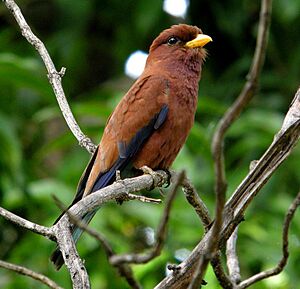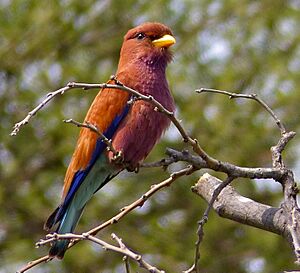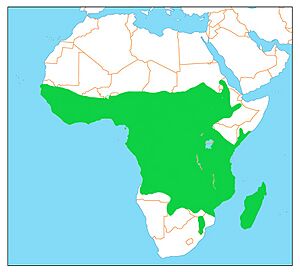Broad-billed roller facts for kids
Quick facts for kids Broad-billed roller |
|
|---|---|
 |
|
 |
|
| Nominate race in Madagascar (above) E. g. suahelicus in South Africa (below) | |
| Conservation status | |
| Scientific classification | |
| Genus: |
Eurystomus
|
| Species: |
glaucurus
|
 |
|
| native range | |
| Synonyms | |
|
|
The broad-billed roller (Eurystomus glaucurus) is a colorful bird from the roller family. It lives in warm, tropical parts of Africa and Madagascar. These birds like areas that aren't too dry. They usually have their babies during the wet season. When the dry season comes, they travel to wetter places closer to the middle of the Earth.
Contents
Discovering the Broad-billed Roller
The broad-billed roller was first officially described in 1776. A German scientist named Philipp Ludwig Statius Müller gave it the scientific name Coracias glaucurus. The word glaucurus comes from Ancient Greek and means "blue-grey."
Statius Müller learned about this bird from earlier descriptions. A French scientist, Georges-Louis Leclerc, Comte de Buffon, had written about "Le Rollier de Madagascar" in 1775. The first broad-billed roller ever studied came from Madagascar.
Later, in 1816, the broad-billed roller was placed in a new group called Eurystomus. This group was created by a French bird expert, Louis Pierre Vieillot. Scientists have also found that this roller is closely related to the blue-throated roller.
Different Kinds of Broad-billed Rollers
There are four different types, or subspecies, of the broad-billed roller:
- E. g. aethiopicus: This type is found in Ethiopia. It's sometimes called the Nile Valley broad-billed roller.
- E. g. afer: You can find this type from Senegambia to northern Democratic Republic of Congo and South Sudan.
- E. g. suahelicus: This type lives in East Africa. Its range stretches from Somalia to Uganda, northern Zambia, Angola, Mozambique, and northeastern South Africa.
- E. g. glaucurus: This is the original type found in Madagascar. It breeds there but might fly to mainland Africa during winter.
What Does a Broad-billed Roller Look Like?
Broad-billed rollers are about 29–30 centimeters (11-12 inches) long. They have a warm brown color on their back and head. Their throat and chest are a pretty lilac color. The rest of their feathers are mostly brown.
One of their most noticeable features is their bright yellow, wide bill. Both male and female rollers look similar. Young rollers are a bit duller in color than the adults, with a lighter chest.
When these birds fly, they are quite amazing to watch. Their flight is strong and direct. You can see bright blues on their wings and tail, which stand out against their brown back.
Broad-billed Roller Sounds
The broad-billed roller makes a rough, snarling sound. It often sounds like "k-k-k-k-k-r-r-r-r-r."
Where Do Broad-billed Rollers Live?
These birds prefer open woodlands that have some tall trees. They especially like areas that are close to water. You can often spot broad-billed rollers sitting on top of trees, fence posts, or even power lines. They perch very noticeably, almost like a giant shrike.
Broad-billed Roller Habits
Broad-billed rollers are usually not very active during the day. They might chase away other birds that come too close. But in the late afternoon, they become very busy. This is when they hunt for their food.
They love to eat swarming ants and termites. Sometimes, you can see groups of 100 or more rollers hunting together! When they get thirsty, they drink water while flying. They dip their bills into the water, just like swallows do.
When it's time to have babies, broad-billed rollers build their nests in holes in trees. They don't add any soft lining to the nest. A female roller usually lays 2 to 3 eggs.


